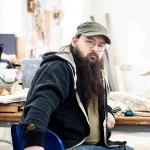-

- Paul McCarthy
Paul
McCarthy

This project explores the shifting visibility of the subject through the interplay of materials and location. Set in my kitchen, the work begins with a self-portrait in which only my head is visible above the countertop — my body is concealed, emphasising my presence through partial visibility. As the performance progresses, I stack plates in front of my face, gradually obscuring it.
The kitchen — a domestic and often overlooked space — becomes a stage where everyday objects slowly diminish subjecthood. The plates function as both material and metaphor: they are familiar, functional items that accumulate, obscuring identity and turning the subject into part of the setting.
By using my image and incorporating common domestic materials, the work questions where the subject resides — in the face, in the space, or the act of concealment. The kitchen isn’t just a backdrop, but an active component of the work, shaping the interaction between self and object. Ultimately, the project reflects on how identity can be veiled or fragmented by our environments and the materials in which we live.
This project examines familial presence and personal history through portraiture, material intervention, and site-specificity. Set in my family yard, in front of the main garage door, I take full-body portraits of my mother and father, each standing as subject within a shared but deeply personal space. The yard, located on the property of my mother’s childhood home, connects to her past, while the garage, built by my father, represents his presence and labour in the present.
After capturing the initial portraits, I began to obscure them by stacking tyres in front of their bodies. The tyres, functional and physical, are also symbolic. As materials tied to my father’s mechanical work in the garage, they serve both as markers of identity and tools of partial erasure. As with the first project, the act of concealment becomes a way to reflect on presence, not through disappearance, but through interaction with place and material.
This work reflects on how subjecthood is shaped by environment and history. The location carries layered significance — it is a point of convergence for my parents’ lives, stories, and contributions. Through this process, the portraits become more than images of people: they are quiet negotiations between self, material, and memory embedded in place


The Cunneen Collection
The Cunneen Collection is a series of three large photographic prints exploring generational presence, labour, and identity through material and site. The work features portraits of three generations of the Cunneen family — John Cunneen (father), his son, and John’s uncle Sean — each situated at Cunneen Sand and Gravel, the family’s business, which is embedded within the same community they’ve lived in for generations.
Each subject is positioned behind a constructed wall built from materials drawn directly from their working environment: full pallets of concrete blocks for John, sandbags for his son, and stacked pallets for Sean. These materials are not only utilitarian but deeply symbolic, referencing the family’s trade, the passage of time, and the burden or support of inherited roles. John’s portrait features the largest and most physically demanding structure, assembled using a forklift, reflecting both scale and seniority. The structures built in front of each subject grow and diminish across the timeline, forming an implied pyramidal shape within the prints, echoed by their physical installation on the gallery wall.
This pyramid — rising and falling — speaks to the cyclic nature of labour, generational continuity, and the ebb and flow of identity shaped through work and place. The location is central, serving as both a site of livelihood and a living archive of family history. By documenting these processes photographically, the project honours not only the individuals but the weight of their shared environment, questioning how identity is constructed, passed down, and physically embedded in the spaces we build and maintain.